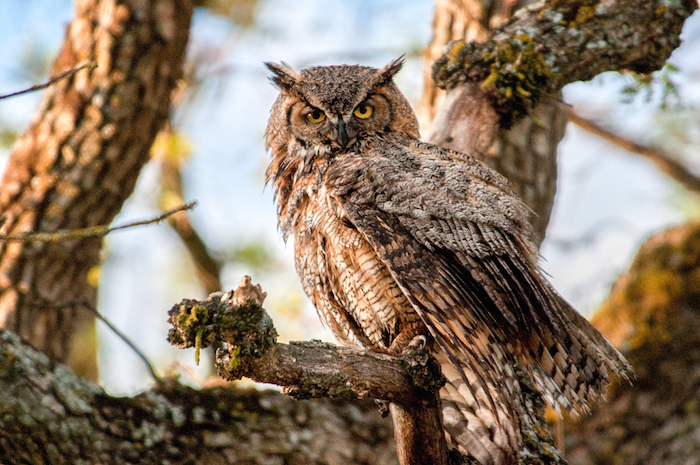
Great Horned Owl
Who-h’hoo-hoo-hoo! Not a Halloween ghost, but an owl. Some owls are smaller than robins, others bigger than your poodle, but they live all around us, locally and worldwide, almost invisibly.
Most common in North America is the Great Horned Owl. It’s not really horned—just feather-tufted—but these owls have the hearing, eyesight, feathering, talons, and instincts that make them formidable nighttime spooks .
Being nocturnal, the owls must keep warm. Their thick blanket of soft feathers does the job. Their feathering is so plush that a child’s finger poked into it can disappear. The Great Horned Owl is about the size of a housecat, but weighs only half as much, maybe four pounds. The rest is feathers.
The softness of these feathers helps insulate the birds, but it also promotes their silence. You may have heard the stiff flapping of, say, a raven winging by in daylight hours. But the owl’s feathers, soft and fringed at the wings, slip silently through the air, so that an unsuspecting rat is given no warning of its doom.
“No warning” is important. Daytime raptors—hawks and eagles—generally catch their quarry only 20% of the time. Snatching prey in the night can only be more difficult.
But owls are up to the task. They have huge eyes; imagine tennis balls on our human faces. Their pupils can open wide to catch dim shades in the dark. Their retinas are rich in rod cells, the photoreceptors that see only black and white, but still see when color receptors have shut down with dusk. Their huge eyes leave no room for their pupils to slide left-right as ours do, but they compensate with 14 vertebrae in their neck, twice our number, allowing their famous three-quarter head swivel.
Owl hearing is exceptional. Their cheek feathers form two little dishes that funnel sound into their ears, one on each side of the head, one high and one low. That high/low offset helps the owl pinpoint the source of a sound, much as a dog will by cocking its head. Tests on barn owls have shown their ability to capture prey in total darkness, by sound alone.
Once its prey is located, a hunting Great Horned Owl will loft from its perch and wing forward like a shadow. Its talons—not the typical three toes forward, 1 toe back of songbirds, but rather angled two forward/two back—will encircle its prey. Scarily strong—reported to be able to pop a steel-belted tire—the talons will pierce the lungs or heart.
Great Horned Owls are not picky eaters. They may hop on the ground to snatch scorpions and other invertebrates; they may eat frogs, mice, rats, or rabbits; coots, ducks, or other birds; squirrels, cats, or, thanks to an absent sense of smell, skunks.
Their nocturnal versatility—night, after all, happens all over—permits Great Horned Owls to live in forests, fields, wetlands, and deserts. They hoot to establish a territory and to coax a mate. In spite of her larger size, she hoots the alto and he hoots the bass. All dueted up, they will nest in trees, in stick nests or cavities, or in old barns, or on rock ledges, where they will deliver shreds of the local vermin to their hungry chicks.
And at this Halloween time of year, you may hear their hoots, but also the hisses, shrieks, barks, whistles, and wavering cries with which owls haunt the darkened skies.

No comments yet.